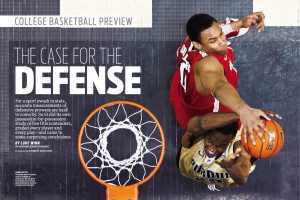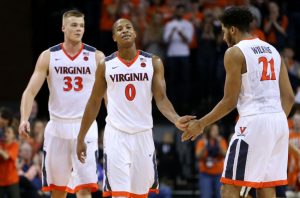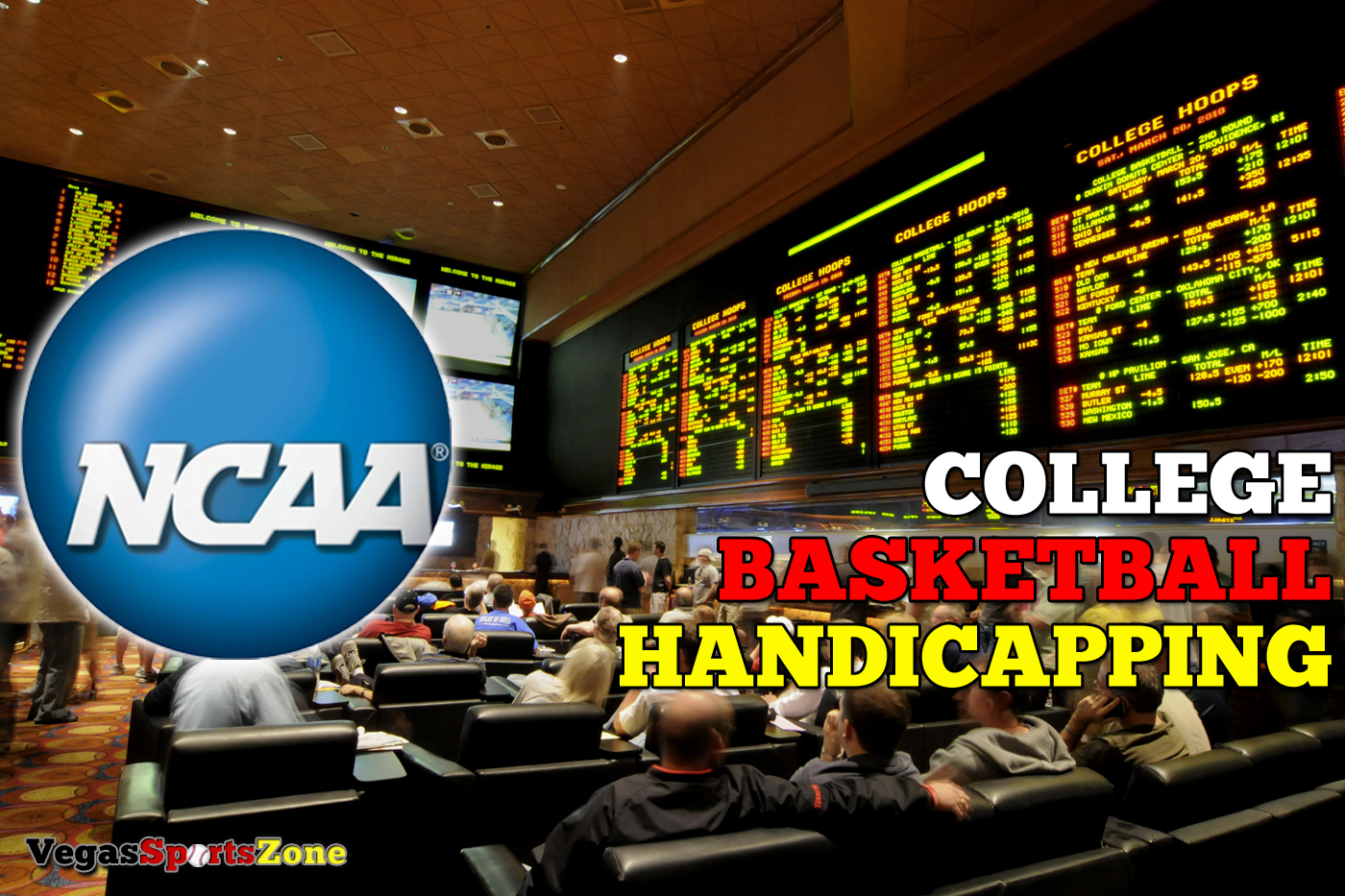College Basketball Handicapping – Defensive Dominators
Analyzing College Basketball’s Defensive Dominators and Applying Stat Profiles
This article was posted last week at osga.com.
It’s been 30 years since the advent of the three-pointer and the shot clock changed the face of college basketball. The three-point shot has allowed teams to overcome larger deficits and created tremendous excitement for the game. However, handicapping a team’s ability to make outside shots on a given night can become a bit frustrating at times with such variance.
In addition, the new rules changes and reduction in shot clock to 30 seconds have sped up the game, allowing more freedom of movement and benefitting the more athletic teams. That’s not to say it’s all good for the game, and handicappers, bettors and sports books alike have had to adjust.
Still, the basic principles and fundamental focus remains of great importance in college basketball. On offense the team must value the basketball with a positive assist to turnover ratio. Good shot selection remains an absolute must if a team wants to experience success. Thus coaching philosophies and the concepts of boxing out and rebounding are key to increasing the number of possessions, as is the percentage of loose balls and steals a team can create. Converting a high percentage of foul shots is important, especially late in games.
 Yet when determining a team’s success in college basketball there can be little dispute that the opponent’s field goal percentage is of key importance. Field goal percentage defense is more important than points allowed because an opponent’s points can be determined to a degree by the number of possessions they have which in turn can be influenced by an offensive pace that creates lower overall possessions in a game. Efficiency and tempo are key, and when you review the adjusted defensive numbers, you’ll see some of the nations top teams in the top-20 defensive efficiency rankings – So. Carolina, Louisville, Gonzaga, Virginia, Baylor, Florida, Cincinnati, Wisconsin, West Virginia, Kentucky, Oregon, Arizona, Miami, FL and Villanova. Some other teams that have cracked the top-20 defensive efficiency numbers have gone from losing seasons to significant improvement and winnings seasons this year thanks to much improved defensive play: Alabama, Central Florida and Minnesota. And Illinois State is undefeated in the Missouri Valley Conference with with one of the nation’s top defensive teams having also given conference king pin Wichita State their only conference loss.
Yet when determining a team’s success in college basketball there can be little dispute that the opponent’s field goal percentage is of key importance. Field goal percentage defense is more important than points allowed because an opponent’s points can be determined to a degree by the number of possessions they have which in turn can be influenced by an offensive pace that creates lower overall possessions in a game. Efficiency and tempo are key, and when you review the adjusted defensive numbers, you’ll see some of the nations top teams in the top-20 defensive efficiency rankings – So. Carolina, Louisville, Gonzaga, Virginia, Baylor, Florida, Cincinnati, Wisconsin, West Virginia, Kentucky, Oregon, Arizona, Miami, FL and Villanova. Some other teams that have cracked the top-20 defensive efficiency numbers have gone from losing seasons to significant improvement and winnings seasons this year thanks to much improved defensive play: Alabama, Central Florida and Minnesota. And Illinois State is undefeated in the Missouri Valley Conference with with one of the nation’s top defensive teams having also given conference king pin Wichita State their only conference loss.
As a result a team’s overall defensive field goal percentage and three-point field goal percentage defense remain key indicators when judging a team’s defensive ability. These must work in tandem to be efficient since a team can pack the paint defensively to minimize higher percentage two-point shots while sacrificing defense outside the arc. Conversely, too much attention to perimeter defense can sacrifice a team’s ability to defend the paint. When a team combines solid defensive play with rebounding strength and the ability to block or alter shots, you have a team that is capable of competing most any night against any team.
Yet, while strong defensive play is often key to winning more basketball games, a team must also take care of the basketball, minimize turnovers, take good shots and control the boards. Thus, I’ve included a link to reference stronger teams in rebounding rate.

Virginia coach Tony Bennett has the Cavaliers among the nation’s elite defenses again
With these concepts in mind it’s up to the handicapper and sports bettor to determine a team’s motivation level, how they match-up with each opponent and how these statistics can be used and adjusted throughout the season based on quality of opponent faced. Some teams play softer schedules and opponents in the early part of the season while also adjusting to new players, coaches and systems. I like to focus on “conference only” statistics as a more accurate barometer of a team’s overall strength. As teams push towards the finish of the conference season and into postseason play, we have a more accurate barometer near the halfway point of most team’s conference schedule.
The stats below are season-long numbers and it’s up to you to dig deeper into a team’s stat profile and recognize opponents faced, home/road splits, player injury impact, motivational factors and other scheduling and situations while also recognizing the importance of quality coaching.
Through January 27, 2017 here are the top defensive teams that are allowing 41% or less field goal percentage defense, 33% or less shooting from behind the arc and 67 points or less per game. I’ve also noted how these defensive dominators do in rebounding the basketball and provided their Adjusted Defensive Efficiency Ranking from KenPom (351 teams).
Additional key stats to evaluate and use are rebounding margin and assist/turnover ratio, as positive ratios in those categories strengthen a team’s overall and defensive profile even further.
Also, some teams not on the list are solid defensive teams and may have positive coaching profiles. These teams just miss qualifying in various categories including rebounding margin, but may rank top-50 in adjusted defensive efficiency:
Alabama, Cal State Bakersfield, Cal Irvine, College of Charleston, Colorado State, Dayton, Florida State, Georgia, Kansas State, UMASS, St. Mary’s, Wisconsin
Use some of these stat profiles as a guide when handicapping the rest of the college basketball season along with the college conference tournaments (CCT’s), NCAA Tournament, NIT and other post season tournaments. Also utilize and reference this list for early season play next year when factoring in returning starters, coaching philosophy and a team’s defensive strength in a system.
Note the stats below are from games against Division 1 opponents only.
PPG – Points Per Game Defense
| Team – Conference | FG% Defense | 3-point % Defense | Rebounding Margin | PPG | Adj Def Rank |
| Central Florida – AAC | 34.8 | 29.2 | 11.9 | 59 | 10 |
| Illinois State – MVC | 36.9 | 31.6 | 2.9 | 62 | 12 |
| Cincinnati – AAC | 37 | 32.3 | 5.5 | 62 | 8 |
| Gonzaga – West Coast | 37.2 | 29.6 | 5.7 | 62 | 5 |
| South Carolina – SEC | 37.4 | 26.7 | 2.8 | 61 | 1 |
| Louisville – ACC | 37.8 | 28.2 | 7.3 | 62 | 2 |
| East Carolina – AAC | 38 | 31 | 1.5 | 63 | 53 |
| Baylor – Big 12 | 38.1 | 29.8 | 8.3 | 61 | 4 |
| Virginia – ACC | 38.5 | 31.9 | 4.8 | 53 | 3 |
| Northwestern – Big 10 | 38.6 | 30.4 | 2.6 | 64 | 39 |
| Wichita State – MVC | 38.6 | 32.5 | 8.4 | 64 | 41 |
| Oregon – Pac 12 | 38.9 | 30.3 | 5.9 | 63 | 11 |
| Minnesota – Big 10 | 38.9 | 29.6 | 0.6 | 67 | 6 |
| Connecticut – AAC | 39 | 31.9 | 1.3 | 65 | 50 |
| SMU – AAC | 39.3 | 32.9 | 11 | 59 | 37 |
| Georgia Tech – ACC | 39.3 | 32.6 | 0.7 | 67 | 22 |
| San Diego State – MWC | 39.4 | 32.4 | 0.7 | 62 | 35 |
| California – Pac 12 | 39.4 | 32.5 | 8.1 | 63 | 18 |
| Rutgers – Big 10 | 39.4 | 32 | 7.3 | 66 | 52 |
| Miami – ACC | 39.9 | 31.7 | 6.8 | 63 | 28 |
| Maryland – Big 10 | 40.1 | 31.8 | 2.5 | 66 | 30 |
| Arizona – Pac 12 | 40.1 | 29.7 | 7.4 | 63 | 16 |
| Purdue | 41 | 32.9 | 9.4 | 66 | 23 |
| Villanova – Big East | 41 | 30.2 | 5.1 | 62 | 21 |
| West Virginia | 41 | 32.8 | 3.4 | 65 | 7 |

 Twitter
Twitter Facebook
Facebook